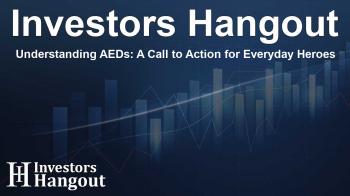Understanding AEDs: A Call to Action for Everyday Heroes

Understanding the Importance of AEDs in Cardiac Emergencies
In today's world, a growing concern surrounds cardiac emergencies, prompting discussions about the role of bystanders during such crises. A recent survey sheds light on how essential an Automated External Defibrillator (AED) is and the need for immediate action. Despite the fact that 90% of Americans wish a bystander would intervene during a cardiac event, less than half feel capable or responsible for doing so. This alarming disconnect underscores the urgent need for public education regarding AED usage.
The Impact of AED Education on Lifesaving Actions
The survey, conducted by The Harris Poll and commissioned by ZOLL Medical, shared that while a significant majority expect assistance from those around them in emergencies, skepticism remains about personal responsibility for utilizing an AED. Specifically, 54% of the individuals surveyed expressed uncertainty about initiating help, demonstrating the need for campaigns that promote confidence and understanding in using AEDs appropriately during a crisis.
Clearing Up Common Misconceptions About AEDs
Many lack crucial knowledge about AED operation, which can inhibit their willingness to act in emergencies. Surprisingly, 41% of respondents were unaware that using an AED simply requires turning it on and following the on-screen instructions. The HEARTS Act is making strides to change this narrative, advocating for broader access and awareness about AEDs across communities.
Three Key Myths About AED Use That Need Addressing
Several myths may be deterring potential lifesavers from taking action. First, there is a misconception about the role of calling 911. While 96% correctly identify this as their primary responsibility, they often overlook that emergency medical services (EMS) typically take 7 to 14 minutes to respond. In contrast, immediate application of CPR or an AED can greatly increase survival chances during the critical first minutes of a medical crisis.
A second concern is related to the feedback mechanisms of AEDs. Although many individuals believe that calling 911 and retrieving an AED is the best action, 32% feel hesitant to use an AED due to a lack of knowledge. It is worth noting that nearly half (45%) would feel more empowered if AEDs provided coaching through audio and visual cues, enhancing their comfort and willingness to intervene.
The third myth revolves around the accessibility of AEDs. Less than half (49%) of survey participants reported confidence in locating an AED in public spaces. Programs like the HEARTS Act endeavor to improve this scenario, ensuring that AEDs become increasingly accessible to the general public, and further enabling bystanders to make a difference.
Invitation to the Community: Be Prepared to Act
As awareness about AEDs grows, ZOLL Medical is taking noticeable steps to promote effective public education. The company's Anything Can Happen. Anyone Can Help.™ initiative, exemplified by collaborations with advocates such as professional football player Damar Hamlin, aims to illustrate how readily available AEDs can empower everyday citizens. To ensure that everyone understands how to utilize these life-saving tools, real-time feedback offered by many of these devices empowers users to respond effectively in emergencies.
It’s essential for communities to embrace the principle that anyone can aid in emergencies. This simple message can save lives, as the public becomes more aware of how straightforward it is to operate an AED. Encouraging participation in educational programs can lead to a more prepared society, where individuals feel equipped to handle cardiac episodes effectively.
Frequently Asked Questions
What is the primary purpose of an AED?
An AED is a portable device that can diagnose life-threatening cardiac arrhythmias and treat them through defibrillation, essentially restoring normal heart function during emergencies.
Why is bystander intervention crucial in a cardiac emergency?
Bystander intervention can significantly reduce the time before the victim receives life-saving treatment, thus improving their chances of survival before EMS personnel arrive.
What are the main barriers preventing effective AED usage?
Lack of knowledge, uncertainty about personal responsibility, and misconceptions about AED operation are significant barriers that prevent effective use of these devices during emergencies.
How can communities promote AED awareness?
Communities can host training sessions, distribute educational materials, and increase the visibility of AEDs in public spaces to promote awareness and preparedness.
How can public access to AEDs be improved?
Legislation like the HEARTS Act aims to increase the distribution and accessibility of AEDs in public facilities, ensuring they are readily available in case of emergencies.
About The Author
Contact Owen Jenkins privately here. Or send an email with ATTN: Owen Jenkins as the subject to contact@investorshangout.com.
About Investors Hangout
Investors Hangout is a leading online stock forum for financial discussion and learning, offering a wide range of free tools and resources. It draws in traders of all levels, who exchange market knowledge, investigate trading tactics, and keep an eye on industry developments in real time. Featuring financial articles, stock message boards, quotes, charts, company profiles, and live news updates. Through cooperative learning and a wealth of informational resources, it helps users from novices creating their first portfolios to experts honing their techniques. Join Investors Hangout today: https://investorshangout.com/
The content of this article is based on factual, publicly available information and does not represent legal, financial, or investment advice. Investors Hangout does not offer financial advice, and the author is not a licensed financial advisor. Consult a qualified advisor before making any financial or investment decisions based on this article. This article should not be considered advice to purchase, sell, or hold any securities or other investments. If any of the material provided here is inaccurate, please contact us for corrections.

